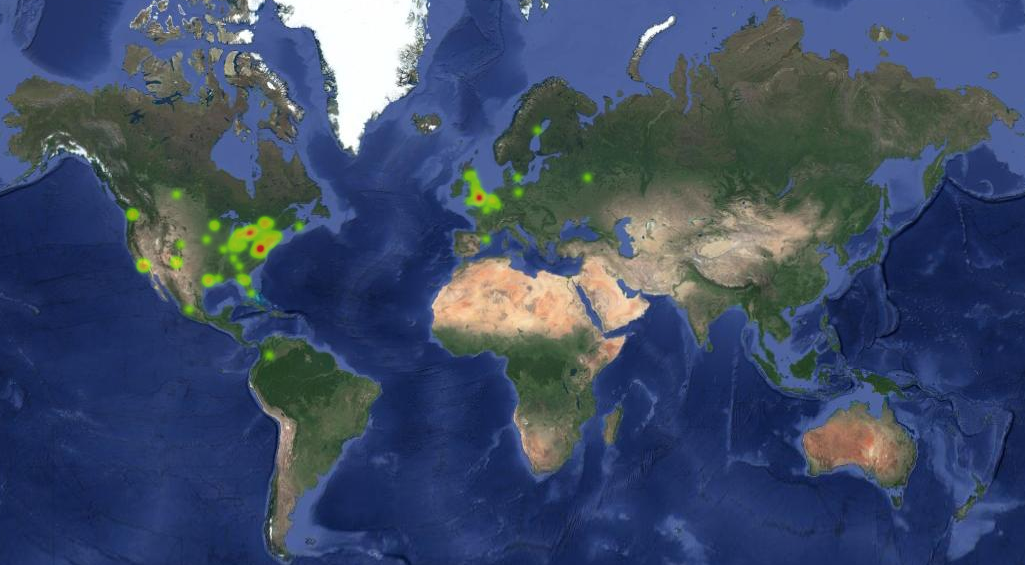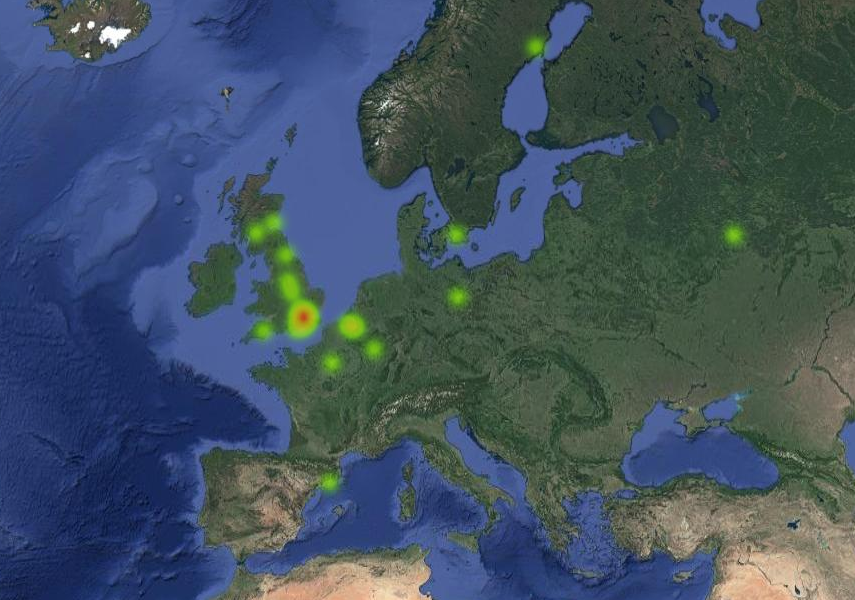 Heatmap of Contributors to The Programming Historian since launch. Map produced using Google Fusion Tables.
Heatmap of Contributors to The Programming Historian since launch. Map produced using Google Fusion Tables.
It sounds cheesy, but projects like the Programming Historian don’t exist without people freely giving their time, energy, and passion. Part of our sustainability plan has always been to ensure the project wasn’t reliant upon grant funding, and that means we’ve had to work hard to entice volunteers to sustain our efforts. To ensure our relationship was mutually beneficial rather than one-way, we’ve always tried to make sure contributors were properly credited for their efforts.
Since we launched in July 2012, we’ve done our best to keep track of everyone who has been part of the project. That includes authors, project team members, reviewers, and contributors to our blog. We’ve done a pretty good job of that (though I realise that we only have a list of reviewer names in lessons that eventually were accepted for publication and not those that didn’t make it through peer review).
Our growing list includes 112 people in at least 13 countries, on 3 continents. Most of them are associated with universities in one way or another. We have 73 universities represented amongst our contributors. Predominantly our contributors are academics, graduate students, or people working in university libraries, but there are also those who work for scholarly societies, freelance scholars, designers, consultants, and even someone working for the U.S. House of Representatives.

Heatmap of North American Contributors to The Programming Historian since launch. Map produced using Google Fusion Tables.
We owe a huge debt of thanks in particular to George Mason University (9 contributors), Western University (6), University of California Los Angeles (5), the British Library (3), Carleton University (3), Rice University (3), and the University of New Mexico (3).
33 of our contributors are women, and 79 are men. We’re committed to diversity, so we’ll continue to work towards bringing those numbers closer to parity. To help us do that, please encourage female colleagues, friends, and students to consider proposing a tutorial. If you are a woman with an idea for a lesson, we’d be very happy to hear from you.

Heatmap of European Contributors to *The Programming Historian* since launch. Map produced using Google Fusion Tables.
The breakdown of contributors by country:
- The United States: 61
- Canada: 19
- The United Kingdom: 16
- Belgium: 3
- Colombia: 1
- Finland: 1
- France: 1
- Germany: 1
- Luxembourg: 1
- Mexico: 1
- Russia: 1
- Spain: 1
- Sweden: 1
The maps show that we’ve done a great job of bringing people together across North America and the UK, but there’s clearly more work to be done to ensure the Programming Historian becomes a truly global community. We hope that our new (and hard at work) Spanish language team will help us grow the project in Central and South America.
If anyone has African, Asian, or Australasian connections that would like to get involved, please encourage them to drop us a line.
A big thanks to everyone who has made this project possible thus far. The Programming Historian is people. We’re truly grateful of all of you.

Heatmap of British Contributors to The Programming Historian since launch. Map produced using Google Fusion Tables.
Our contributors to date:
- Eli Pousson, Baltimore Heritage
- James Baker, British Library
- Nora McGregor, British Library
- Andrew Dunning, British Library
- Daniel Macfarlane, Carleton University
- Shawn Graham, Carleton University
- Robert Blades, Carleton University
- Daniel van Strien, City University, London
- Nabeel Siddiqui, College of William and Mary
- Dennis Tenen, Columbia University
- Grant Wythoff, Columbia University
- Marten Düring, CVCE Luxembourg
- Thomas J. Duck, Dalhousie University
- Russell Alleen-Willems, Diachronic Design (Seattle)
- Nick Pearce, Durham University
- Victor Gayol, El Colegio de Michoacán, A.C. (CPI-CONACYT)
- Sara Palmer, Emory University
- Charlotte Tupman, Exeter University
- Will Hanley, Florida State University
- Ethan Miller, Freie Universität Berlin
- Maria José Afanador-Llach, Fundación Histórica Neogranadina
- Amanda Morton, George Mason University
- Jeri Wieringa, George Mason University
- Megan R. Brett, George Mason University
- Spencer Roberts, George Mason University
- Shiela Brennan, George Mason University
- Erin N. Bush, George Mason University
- Celeste Tưởng Vy Sharpe, George Mason University
- Ben Hurwitz, George Mason University
- Patrick Murray-John, George Mason University
- Matthew Lincoln, Getty Research Institute
- Boris Capitanu, HathiTrust Research Centre
- Peter Organisciak, HathiTrust Research Centre
- Seth Bernstein, Higher School of Economics, Moscow
- Jeanette Sewell, Houston Area Digital Archives
- Jon Crump, Independent, Seattle
- Scott Weingart, Indiana University
- M. H. Beals, Loughborough University
- Patrik Persson, Lund University
- Stéfan Sinclair, McGill University
- Kellen Kurschinski, McMaster University
- John Fink, McMaster University
- Ezra Brooks, Michigan State University
- Jonathan Reeve, Modern Language Association
- Ryan Cordell, Northeastern University
- Abby Schreiber, Ohio State University
- Aurélien Berra, Paris-Ouest University
- John Russell, Penn State University
- Amanda Visconti, Purdue University
- Brandon Hawk, Rhode Island College
- Caleb McDaniel, Rice University
- Lisa Spiro, Rice University
- Sean Morey, Rice University
- Jamie Howe, Rutgers University
- Joanna Swafford, SUNY
- Rob Sieczkiewicz, Susquehanna Library
- Chris Forster, Syracuse University
- Laura Turner O’Hara, U.S. House of Representatives
- Allison Hegel, UCLA
- Carrie Sanders, UCLA
- Miriam Posner, UCLA
- Dave Shepard, UCLA
- Michelle Moravec, UCLA
- Finn Arne Jørgensen, Umea University
- Antonio Rojas Castro, Universitat Pompeu Fabra
- Max De Wilde, Université libre de Bruxelles
- Seth van Hooland, Université libre de Bruxelles
- Tessa C Hauswedell, University College London
- Eira Tansey, University of Cincinnatti
- Vilja Hulden, University of Colorado Boulder
- Jacob Greene, University of Florida
- Jason Crider, University of Florida
- Adam Crymble, University of Hertfordshire
- Jane Winters, University of London
- Jonathan Blaney, University of London
- John Laudin, University of Louisiana at Lafayette
- Paige Morgan, University of Miami
- Elizabeth Venditto, University of Minnesota
- Evan Taparata, University of Minnesota
- Jason Heppler, University of Nebraska
- Fred Gibbs, University of New Mexico
- Guy McClellan, University of New Mexico
- Justin Larsen, University of New Mexico
- Jeff Bain-Conkin, University of Notre Dame
- Sarah Simpkin, University of Ottawa
- Nancy Lemay, University of Ottawa
- Jim Clifford, University of Saskatchewan
- Sharon Howard, University of Sheffield
- Konrad Lawson, University of St Andrews
- Heather Froehlich, University of Strathclyde
- John Levin, University of Sussex
- Kim Pham, University of Toronto
- Jeremy Boggs, University of Virginia
- Luke Bergmann, University of Washington
- Ian Milligan, University of Waterloo
- Ruben Verborgh, Universtiteit Gent
- Ted Dawson, Vanderbilt University
- Brandon Walsh, Washington and Lee University
- Doug Knox, Washington University in St Louis
- Peter Webster, Webster Research and Consulting
- Alan MacEachern, Western University
- Josh MacFadyen, Western University
- Taryn Dewar, Western University
- William J. Turkel, Western University
- Mary Beth Start, Western University
- Tim Compeau, Western University
- Catherine DeRose, Yale University
- Nick Ruest, York University
- Patrick Burns, Affiliation Unknown (please let me know)
- Eduardo Sanchez, Affiliation Unknown (please let me know)
- Derek Price, Affiliation Unknown (please let me know)
- Jeff Veitch, Affiliation Unknown (please let me know)
If I’ve missed you or made a mistake, let me know so I can update our records.
About the author
Adam Crymble is Associate Professor of Digital Humanities at University College London.